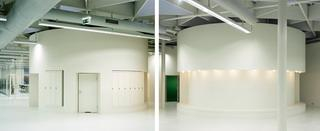FRABA sp.zo.o.
As a non-hierarchical, uniformed, infinite and flexible space FRABA sp.zo.o. is a meta generic production plant and a manufacturing prototype for an automation components company. FRABA produces electronic components for the automation industry in a non-automated manufacturing process. The products are hand-assembled in small series. The assembly consists of tables, shelves and trolleys.
The first production plant in Slubice, Poland was completed in November 2006.
On a tight gross budget of 580/m² a model for future expansions around the globe has been developed. The design reacts to location specific construction and logistic conditions for each site. In Poland there is a sufficient supply of timber at considerable low costs compared to the conventional steel structure. The fact that the global steel market is overheated by Chinese demands, combined with the affordable labour cost in Poland, means that a lightweight timber structure becomes reasonable.
The structural system consists of a 52 m diameter 60°solid web beam grid. It rests on 19 stressed steel tube columns that are 17 cm in diameter with a clear span of 9,70 m. The shell is made of prefabricated insulated plywood elements and 14% of the roof is covered with prefabricated vaulted skylight sheds. The top surface is aluminium coated bituminous roofing membrane. Gross floor area is 2069 m² with an overall clearance of 4,5 m. The building has mechanical and conditioned ventilation. Skylights are specifically designed for perfect daylight assembly conditions and avoid heat gains during the summer.
The circle is an optimised box. In comparison to a rectangular building of the same size it has less surface and less volume. Additionally to energy savings it permits the saving of up to 13 % in construction material. The triangular grid minimises the construction material while offering a maximum of possible layout variations.
The dimension of the triangular grid is adapted to the needs of the company. In terms of layout the triangular grid offers much more flexibility than the orthogonal one. It is optimised for the customers production process as well as for possible future uses.












